Electronic Nose: Recent Developments in Gas Sensing and Molecular Mechanisms of Graphene Detection and Other Materials
Abstract
:1. Introduction
2. Sensing Mechanisms and Methods to Improve the Sensitivity of Carbon Nanotubes, Porphyrins, and Graphene Sensors
2.1. Sensors Based on Carbon Nanotubes
2.2. Sensors Based on Porphyrins and Hybrids
2.3. Sensors Based on Graphene and Graphene Oxides
2.4. Graphene and Hybrid Sensors
3. The Proposed Interpretation of the Sensing Mechanism based on Influence the Metals and Substituents on the Electronic System
4. Conclusions
Author Contributions
Funding
Acknowledgments
Conflicts of Interest
References
- Axel, L. Scents and Sensibility: A Molecular Logic of Olfactory Perception; Nobel Lecture: New York, NY, USA, 2004. [Google Scholar]
- Bockaert, J. G-protein coupled receptors. Nobel Prize 2012 for chemistry to Robert J. Lefkowitz and Brian Kobilka. Med. Sci. 2012, 28, 1133–1137. [Google Scholar]
- Fernandes, M.P.; Venkatesh, S.; Sudarshan, B.G. Early detection of lung cancer using nano-nose—A review. Open Biomed. Eng. J. 2015, 9, 228–233. [Google Scholar] [CrossRef] [Green Version]
- Bach, J.P.; Gold, M.; Mengel, D.; Hattesohl, A.; Lubbe, D.; Schmid, S.; Tackenberg, B.; Rieke, J.; Maddula, S.; Baumbach, J.I.; et al. Measuring compounds in exhaled air to detect Alzheimer’s disease and Parkinson’s disease. PLoS ONE 2015, 10, e0132227. [Google Scholar] [CrossRef] [Green Version]
- Roine, A.; Veskimae, E.; Tuokko, A.; Kumpulainen, P.; Koskimaki, J.; Keinanen, T.A.; Hakkinen, M.R.; Vepsalainen, J.; Paavonen, T.; Lekkala, J.; et al. Detection of prostate cancer by an electronic nose: A proof-of-principle study. J. Urol. 2014, 192, 230–234. [Google Scholar] [CrossRef]
- Capelli, L.; Taverna, G.; Bellini, A.; Eusebio, L.; Buffi, N.; Lazzeri, M.; Guazzoni, G.; Bozzini, G.; Seveso, M. Application and uses of electronic noses for clinical diagnosis on urine samples: A review. Sensors 2016, 16, 1708. [Google Scholar] [CrossRef] [Green Version]
- Chiu, S.W.; Tang, K.T. Towards a chemiresistive sensor-integrated electronic nose: A review. Sensors 2013, 13, 14214–14247. [Google Scholar] [CrossRef] [Green Version]
- Alizadeh, T.; Hamedsoltani, L. Managing of gas sensing characteristic of a reduced graphene oxide based gas sensor by the change in synthesis condition: A new approach for electronic nose design. Mater. Chem. Phys. 2016, 183, 181–190. [Google Scholar] [CrossRef]
- Pearce, T.C.; Schiffman, S.S.; Nagle, H.T.; Gardner, J.W. Handbook of Machine Olfaction—Electronic Nose Technology; Wiley-VCH Verlag GmbH & Co: Weinheim, Germany, 2003. [Google Scholar]
- Llobet, E.; Hines, E.; Gardner, J.; Franco, S. Non-destructive banana ripeness determination using a neural network-based electronic nose. Meas. Sci. Technol. 1999, 10, 538–548. [Google Scholar] [CrossRef]
- Wongchoosuk, C.; Wisitsoraat, A.; Tuantranony, A.; Kerdcharoen, T. Sensors & Actuators B; Elsevier: Amsterdam, The Netherlands, 2010; pp. 392–399. [Google Scholar]
- Gardner, J. Detection of vapors and odours from a multisensor array using pattern recognition part 1. Principal Component and Cluster Analysis. Sens. Actuators B Chem. 1991, 4, 109–115. [Google Scholar] [CrossRef]
- Wei, B.; Hsu, M.; Su, P.; Lin, H.; Wu, R.; Lai, H. A novel SnO2 gas sensor doped with carbon nanotubes operating at room temperature. Sens. Actuators B Chem. 2004, 101, 81–89. [Google Scholar] [CrossRef]
- Espinosa, E.; Ionescu, R.; Chambon, B.; Bedis, G.; Sotter, E.; Bittencourt, C.; Felten, A.; Pireaux, J.; Correig, X.; Llobet, E. Hybrid metal oxide and multiwall carbon nanotube films for low temperature gas sensing. Sens. Actuators B Chem. 2007, 127, 137–142. [Google Scholar] [CrossRef]
- Hieu, N.; Thuyal, L.; Chien, N. Highly sensitive thin film NH3 gaz sensor operating at room temperature based on SO2/MWCNTs composite. Sens. Actuators B Chem. 2008, 129, 888–895. [Google Scholar] [CrossRef]
- Gong, J.; Sun, J.; Chen, Q. Micromachined sol-gel carbon nanotube/SO2 nanocomposite hydrogen sensor. Sens. Actuators B Chem. 2008, 130, 829–835. [Google Scholar] [CrossRef]
- Kerdcharoen, T.; Wongchoosuk, C. Semiconductor Gas Sensors; Woodhead Publish Series: Bangkok, Thailand, 2013; pp. 386–407. [Google Scholar]
- Lorwongtragool, P.; Wisitsoraat, A.; Kerdcharoen, T. An electronic nose for amine detection based on polymer/SWNT-COOH nanocomposite. J. Nanosci. Nanotechol. 2011, 11, 10454–10459. [Google Scholar] [CrossRef] [PubMed]
- Seesaard, T.; Lorwongtragool, P.; Kerdcharoen, T. Development of fabric-based chemical gas sensors for use as wearable electronic noses. Sensors 2015, 15, 1885–1902. [Google Scholar] [CrossRef] [PubMed] [Green Version]
- Wang, Y.; Yeow, J. A review of carbon nanotubes-based gas sensors. J. Sens. 2009, 2009, 1–24. [Google Scholar] [CrossRef]
- Shirsat, M.; Sarkar, T.; Kakoulis, J.; Myung, N.; Kannanath, B.; Spanias, A.; Mulchandani, M. Porphyrin-functionalized single walled carbon nanotube chemiresistive sensor arrays for VOCs. J. Phys. Chem. C 2012, 116, 3845–3850. [Google Scholar] [CrossRef] [Green Version]
- Shah, A.H. Applications of carbon nanotubes and their polymer nanocomposites for gas sensors. InTech 2016, 18, 460–494. [Google Scholar]
- Sarkar, T.; Srinives, S.; Sarkar, S.; Haddon, R.C.; Mulchandani, A. single-walled carbon nanotube–poly (porphyrin) hybrid for volatile organic compounds detection. J. Phys. Chem. C. 2013, 118, 1602–1610. [Google Scholar] [CrossRef]
- Schroeder, V.; Savagatrup, S.; He, M.; Lin, S.; Swager, T. Carbon nanotube chemical sensors. Chem. Rev. 2019, 119, 599–663. [Google Scholar] [CrossRef]
- Penza, M. Carbon nanotube films as a platform to transduce molecular recognition events in metalloporphyrins. Nanotechnology 2011, 22, 125502. [Google Scholar] [CrossRef] [PubMed]
- Tang, R.; Shi, Y.; Hou, Z.; Wei, L. Carbon Nanotube-Based Chemiresistive Sensors. Sensors 2017, 17, 882. [Google Scholar] [CrossRef] [PubMed]
- Calbi, M. Energy barriers at the ends of carbon nanotube bundles: Effects on interstitial adsorption kinetics. Phys. Rev. Lett. 2005, 94, 185–192. [Google Scholar] [CrossRef]
- Burde, J. Physisorption kinetics in carbon nanotube bundles. J. Phys. Chem. C 2007, 111, 5057–5063. [Google Scholar] [CrossRef]
- Fennell, J.; Liu, S.; Azzarelli, J.; Weis, J.; Rochat, S.; Mirica, K.; Ravnsboek, J.; Swager, T. Nanowire chemical/biological sensors: Status and a roadmap for the future. Angew. Chem. Int. Ed. 2016, 55, 1266–1281. [Google Scholar] [CrossRef] [Green Version]
- Peng, N. Sensing mechanisms of carbon nanotube based NH3 gas detectors. InTech 2010, 18, 341–355. [Google Scholar]
- Bilić, A.; Reimers, J. Adsorption of ammonia on the gold (111) surface. J. Chem. Phys. 2002, 116, 8981. [Google Scholar] [CrossRef]
- Liu, J.; Guo, Z.; Meng, F.; Jia, Y.; Liu, J. Novel Single-Crystalline Hierarchical Structured ZnO Nanorods Fabricated via a Wet-Chemical Route: Combined High Gas Sensing Performance with Enhanced Optical Properties. Cryst. Growth Des. 2009, 9, 1716–1722. [Google Scholar] [CrossRef]
- Wisitsoraat, A.; Tuantranont, A.; Thanachayanont, C.; Patthanasettakul, V.; Singjai, P. Electron beam evaporated carbon nanotube dispersed SnO2 thin film gas sensor. J. Electroceramics 2006, 17, 45–49. [Google Scholar] [CrossRef]
- Capuano, R.; Pomarico, G.; Paolesse, R. Corroles-porphyrins: A teamwork for gas sensor arrays. Sensors 2015, 15, 8121–8130. [Google Scholar] [CrossRef] [Green Version]
- Lewandowski, W.; Kalinowska, M.; Lewandowska, H. The influence of metals on the electronic system of biologically important ligands. Spectroscopic study of benzoates, salicylates, nicotinates and isoorates. J. Inorg. Biochem. 2005, 99, 1407–1423. [Google Scholar] [CrossRef] [PubMed]
- Lewandowski, W.; Barańska, H. Comparison of the influence of silver, iron (III) and chromium (III) on the aromatic system of benzoic and salicylic acids in hydrated and anhydrous complexes. Vib. Spectrosc. 1991, 2, 211–220. [Google Scholar] [CrossRef]
- Lewandowski, W.; Fuks, L.; Kalinowska, M.; Koczoń, P. The influence on selected metals on the electronic system of biologically important ligands. Spectrochim. Acta 2003, 14, 3411–3420. [Google Scholar] [CrossRef]
- Versanyi, G.; Lang, L. Assignments for Vibrational Spectra of Seven Hundred Benzene Derivatives; Wiley: New York, NY, USA, 1974; p. 668. [Google Scholar]
- Lewandowski, W.; Proniewicz, L.M.; Nakamoto, K. The infrared spectra of “Base-Free” dioxygen adducts of ruthenium (II) and osmium (II) porphyrins. Inorg. Chim. Acta 1991, 190, 145–148. [Google Scholar] [CrossRef]
- Varghese, S. Two-Dimensional Materials for Sensing: Graphene and Beyond. Electronics 2015, 4, 651–687. [Google Scholar] [CrossRef] [Green Version]
- Schedin, F.; Geim, A.; Morozov, S.; Hill, E.; Blake, P.; Katsnelson, M.; Novoselov, K. Detection of individual gas molecules adsorbed on graphene. Nat. Mater. 2007, 6, 652–655. [Google Scholar] [CrossRef]
- Lipatov, A.; Vareznikov, A.; Wilson, P.; Sysoev, V.; Kolmakov, A.; Sintskil, A. Highly selective gas sensor arrays based on thermally reduced graphene oxide. Nanoscale 2013, 5, 5426–5434. [Google Scholar] [CrossRef] [Green Version]
- Cheng, Q.; Tang, J.; Shinya, N.; Qin, L.C. Co(OH)2 nanosheet-decorated graphene–CNT composite for supercapacitors of high energy density. Sci. Technol. Adv. Mater. 2014, 15, 014206. [Google Scholar] [CrossRef]
- Yang, S.; Li, W.; Ye, C.; Wang, G.; Tian, H.; Zhu, C.; He, P.; Ding, G.; Xie, X.; Liu, Y.; et al. C3N—A 2D Crystalline, Hole-Free, Tunable-Narrow-Bandgap Semiconductor with Ferromagnetic Properties. Adv. Mater. 2017, 29, 1605625. [Google Scholar] [CrossRef]
- Jastrzębska, A.M.; Kurtycz, P.; Olszyna, A.R. Recent advances in graphene family materials toxicity investigations. J. Nanopart. Res. 2012, 14, 1320. [Google Scholar] [CrossRef] [Green Version]
- Akbari, E. An analytical approach to evaluate the performance of graphene and carbon nanotubes for NH3 gas sensor applications. Beilstein J. Nanotechnol. 2014, 5, 726–734. [Google Scholar] [CrossRef] [PubMed] [Green Version]
- Leenaerts, O.; Partoens, B.; Peeters, F. Adsorption of H2O, NH3, CO, NO2, and NO on graphene: A first-principles study. Phys. Rev. B 2008, 77, 125416–125421. [Google Scholar] [CrossRef] [Green Version]
- Latif, U. Graphene hybrid materials in gas sensing applications. Sensors 2015, 15, 30504–30524. [Google Scholar] [CrossRef] [PubMed]
- Novikov, S. Graphene based sensor for environmental monitoring of NO2. Sens. Actuators B Chem. 2016, 236, 1054–1060. [Google Scholar] [CrossRef]
- Nomani, W.K.; Shishir, R.; Qazi, M.; Diwan, D.; Shields, V.B.; Spencer, M.G.; Tompa, G.S.; Sbrockey, N.M.; Koley, G. Highly sensitive and selective detection of NO2 using epitaxial graphene on 6H-SiC. Sens. Actuators B Chem. 2010, 1, 301–307. [Google Scholar] [CrossRef]
- Jafri, S.; Carva, K.; Widenkvist, E.; Blom, T.; Sanyal, B.; Fransson, J.; Eriksson, O.; Jansson, U.; Grennberg, H.; Karis, O. Conductivity engineering of graphene by defect formation. J. Phys. 2010, 43, 45404. [Google Scholar] [CrossRef]
- Sreeprasad, T.; Berry, V. How do the electrical properties of graphene change with its functionalization? Small 2013, 9, 341–350. [Google Scholar] [CrossRef]
- Lai, L.; Chen, L.; Zhan, D.; Liu, J.; Lim, S.; Poh, C.; Shen, Z.; Lin, J. One-step synthesis of NH2-graphene from in situ graphene-oxide reduction and its improved electrochemical properties. Carbon 2011, 49, 3250–3257. [Google Scholar] [CrossRef]
- Zhu, X.; Liu, D.; Chen, Q.; Lin, L.; Jiang, S.; Zhou, H.; Zhaob, J.; Wu, J. A paper-supported graphene–ionic liquid array for e-nose application. Chem. Commun. 2016, 52, 3042–3045. [Google Scholar] [CrossRef]
- Alizadeh, T.; Mirzagholipur, S. A Nafion-free non-enzymatic amperometric glucose sensor based on copper oxide nanoparticles–graphene nanocomposite. Sens. Actuators B Chem. 2014, 198, 438–447. [Google Scholar] [CrossRef]
- Pei, S.; Cheng, H.M. The reduction of Graphene oxide. Carbon 2012, 50, 3210–3228. [Google Scholar] [CrossRef]
- Fernández-Merino, M.; Guardia, L.; Paredes, J.; Villar-Rodil, S.; Solís-Fernández, P.; Martínez-Alonso, A.; Tascón, J. Vitamin C is an ideal substitute for hydrazine in the reduction of graphene oxide suspensions. J. Phys. Chem. C. 2010, 114, 6426–6432. [Google Scholar] [CrossRef]
- Shao, L. Sulfur dioxide adsorbed on graphene and heteroatom-doped graphene: A first-principles study. Eur. Phys. J. B 2013, 86, 54–59. [Google Scholar] [CrossRef]
- Liu, X. Improving SO2 gas sensing properties of graphene by introducing dopant and defect: A first-principles study. Appl. Surf. Sci. 2014, 313, 405–410. [Google Scholar] [CrossRef]
- Zhang, H. DFT study of adsorption and dissociation behavior of H2S on Fe-doped graphene. Appl. Surf. Sci. 2014, 317, 511–516. [Google Scholar] [CrossRef]
- Ma, C. Nitrogen-doped graphene as an excellent candidate for selective gas sensing. Sci. China Chem. 2014, 57, 911–917. [Google Scholar] [CrossRef]
- Niu, F. Nitrogen and silica co-doped graphene nanosheets for NO2 gas sensing. J. Mater. Chem. A 2013, 1, 6130–6133. [Google Scholar] [CrossRef]
- Zhou, Q. DFT study of formaldehyde adsorption on vacancy defected graphene doped with B, N, and S. Chem. Phys. 2014, 440, 80–86. [Google Scholar] [CrossRef]
- Sharma, P.; Sawyer, S. A high responsivity SnO2 hollow nanospheres based ultraviolet photodetector. In Proceedings of the 2016 Lester Eastman Conference (LEC), Bethlehem, PA, USA, 2–4 August 2016. [Google Scholar]
- Ghaddab, B. Detection of O3 and NH3 using tin dioxide/carbon nanotubes based sensors: Influence of carbon nanotubes properties onto sensors sensitivity. Proc. Eng. 2010, 5, 115–118. [Google Scholar] [CrossRef] [Green Version]
- Arnold, M.S.; Zimmerman, J.D.; Renshaw, C.K.; Xu, X.; Lunt, R.R.; Austin, C.M.; Forrest, S.R. Broad spectral response using carbon nanotube/organic semiconductor/C60 photodetectors. Nano Lett. 2009, 9, 3354–3358. [Google Scholar] [CrossRef]
- Hannon, A. Room temperature carbon nanotube based sensor for carbon monoxide detection. J. Sens. Sens. Syst. 2014, 3, 349–354. [Google Scholar] [CrossRef]
- Terranova, M.; Orlanducci, S.; Rossi, M. Carbon Nanomaterials for Gas Adsorption; CRC Press: New York, NY, USA, 2012. [Google Scholar]
- Fernandez, L. Noncovalent Functionalization of 1D and 2D Nanomaterials. Ph.D. Thesis, Universidad Autónoma de Madrid, Madrit, Spain, 2018. [Google Scholar]
- Contes-de Jesus, E.; Li, J.; Cabrera, C.R. Latest advances in modified/functionalized carbon nanotube-based gas sensors. Synth. Appl. Carb. Nanotub. Their Compos. 2013, 337–366. [Google Scholar] [CrossRef] [Green Version]
- Liu, C.; Chang, Y.; Norris, T. Graphene photodetectors with ultra-broadband and high responsivity at room temperature. Nat. Nanotech. 2014, 9, 273–278. [Google Scholar] [CrossRef] [PubMed]
- Wang, T. A review on graphene-based gas/vapor sensors with unique properties and potential applications. Nano Micro Lett. 2016, 8, 95–119. [Google Scholar] [CrossRef] [PubMed] [Green Version]
- Toda, K. Recent progress in applications of graphene oxide for gas sensing: A review. Anal. Chim. Acta 2015, 878, 43–53. [Google Scholar] [CrossRef] [PubMed]
- Song, Z. Sensitive room-temperature H2S gas sensors employing SnO2 quantum wire/reduced graphene oxide nanocomposites. Chem. Mater. 2016, 28, 1205–1212. [Google Scholar] [CrossRef]
- Chang, J. Graphene-based sensors for detection of heavy metals in water: A review. Anal. Bioanal. Chem. 2014, 406, 3957–3975. [Google Scholar] [CrossRef]
- Li, W. Reduced graphene oxide electrically contacted graphene sensor for highly sensitive nitric oxide detection. ACS Nano 2011, 5, 6955–6961. [Google Scholar] [CrossRef]
- Gholizadeh, A. Toward point-of-care management of chronic respiratory conditions: Electrochemical sensing of nitrite content in exhaled breath condensate using reduced graphene oxide. Microsyst. Nanoeng. 2017, 3, 17022–17030. [Google Scholar] [CrossRef] [Green Version]
- Panda, D. Selective detection of carbon monoxide (CO) gas by reduced graphene oxide (rGO) at room temperature. RSC Adv. 2016, 6, 47337–47348. [Google Scholar] [CrossRef]
- Zhou, Y. Gas sensors for CO2 detection based on RGO–PEI films at room temperature. Chin. Sci. Bull. 2014, 59, 1999–2005. [Google Scholar] [CrossRef]
- Navakul, K. A novel method for dengue virus detection and antibody screening using a graphene-polymer based electrochemical biosensor. Nanomed. Nanotech. Biol. Med. 2017, 13, 549–557. [Google Scholar] [CrossRef] [PubMed]
- Alsaedi, D.; Irannejad, M.; Ibrahim, K.; Lmutairi, A.; Ramahi, O.; Yavuz, M. High-responsivity reduced graphene oxide gel photodetectors for visible-light detection with a large detection area and an end-contact interface. J. Mater. Chem. C 2017, 5, 882–888. [Google Scholar] [CrossRef]
- Son, M.; Pak, Y.; Chee, S. Charge transfer in graphene/polymer interfaces for CO2 detection. Nano Res. 2018, 11, 3529–3536. [Google Scholar] [CrossRef]
- Samsonowicz, M.; Hrynaszkiewicz, T.; Świsłocka, R.; Regulska, E.; Lewandowski, W. Experimental and theoretical IR, Raman, NMR spectra of 2-, 3- and 4-aminobenzoic acids. J. Mol. Struct. 2005, 744, 345–352. [Google Scholar] [CrossRef]
- Shin, D.; Choi, S. Graphene-Based Semiconductor Heterostructures for Photodetectors. Micromachines 2018, 9, 350. [Google Scholar] [CrossRef] [Green Version]
- Samsonowicz, M.; Świsłocka, R.; Regulska, E.; Lewandowski, W. Experimental and theoretical IR, Raman, NMR Spectra of 2-, 3- and 4-nitrobenzoic acids. Int. J. Quantum Chem. 2007, 107, 480–494. [Google Scholar] [CrossRef]
- Bednarek, E.; Dobrowolski, J.C.; Dobrosz-Teperek, K.; Sitkowski, J.; Kozerski, L.; Lewandowski, W.; Mazurek, P.J. Theoretical and experimental 1H, 13C, 15N, and 17O NMR spectra of 5-nitro, 5-amino, and 5-carboxy uracils. Mol. Struct. 1999, 482, 333–337. [Google Scholar]
- Castro, M.; Kumar, B.; Feller, J.F.; Haddi, Z.; Amari, A.; Bouchikhi, B. Novel e-nose for the discrimination of volatile organic biomarkers with an array of carbon nanotubes (CNT) conductive polymer nanocomposites (CPC) sensors. Sens. Actuators B Chem. 2011, 159, 213–219. [Google Scholar] [CrossRef]
- Mazurek, A.; Dobrowolski, J.C. Heteroatom incorporation effect in σ- and π-electron systems: The sEDA (II) and pEDA (II) descriptors. J. Org. Chem. 2012, 77, 2608–2618. [Google Scholar] [CrossRef]
- Mazurek, A.; Dobrowolski, J.C. The sEDA(=) and pEDA(=) descriptors of the double bonded substituent effect. Org. Biomol. Chem. 2013, 11, 2997–3013. [Google Scholar] [CrossRef] [PubMed] [Green Version]
- Ozimiński, W.P.; Dobrowolski, J.C. σ- and π-electron contributions to the substituent effect: Natural population analysis. J. Phys. Org. Chem. 2009, 22, 769–778. [Google Scholar] [CrossRef]
- Mazurek, A.; Dobrowolski, J.C. On the incorporation effect of the ring-junction heteroatom. The sEDA (III) and pEDA (III) descriptors. J. Phys. Org. Chem. 2015, 28, 290–297. [Google Scholar]
- Horowitz, G. Drift-diffusion current in organic diodes. Bul. Math. Biol. 2017, 79, 693–737. [Google Scholar]
- Langa, F.; Gómez-Escalonilla, J.M.; Cruz, P. Carbon nanotubes and porphyrins: An exciting combination for optoelectronic devices. J. Porphyr. Phalocyanines 2007, 11, 348–358. [Google Scholar] [CrossRef]
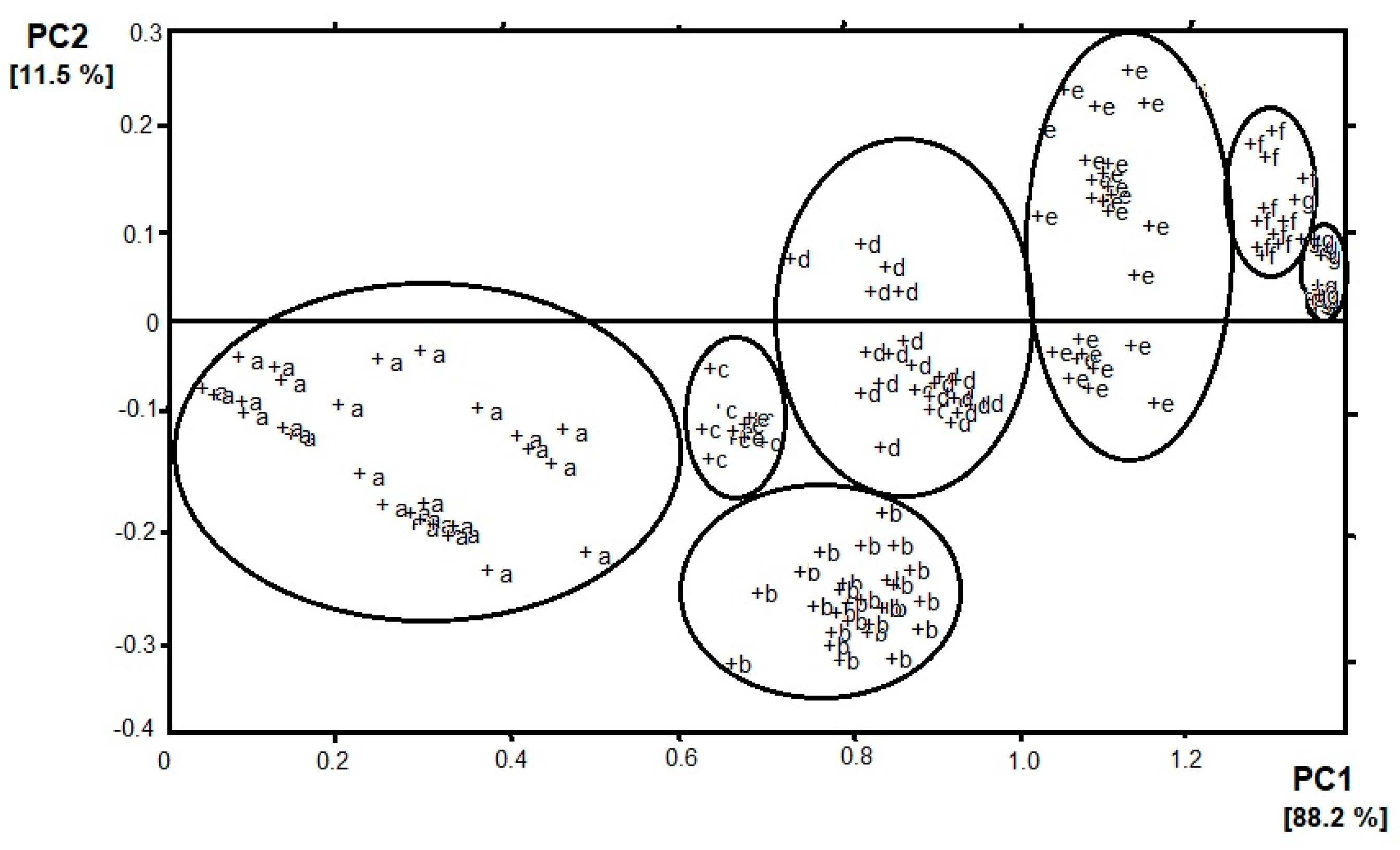

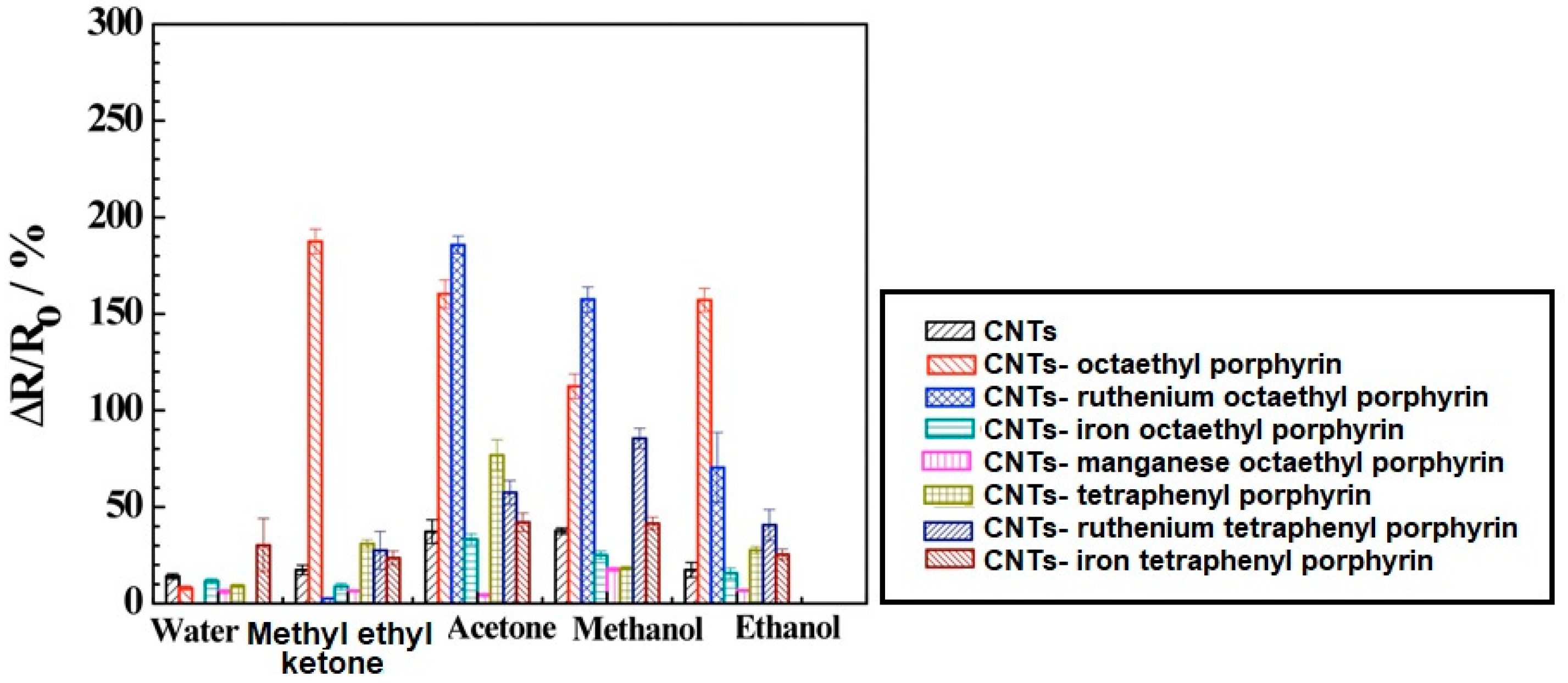
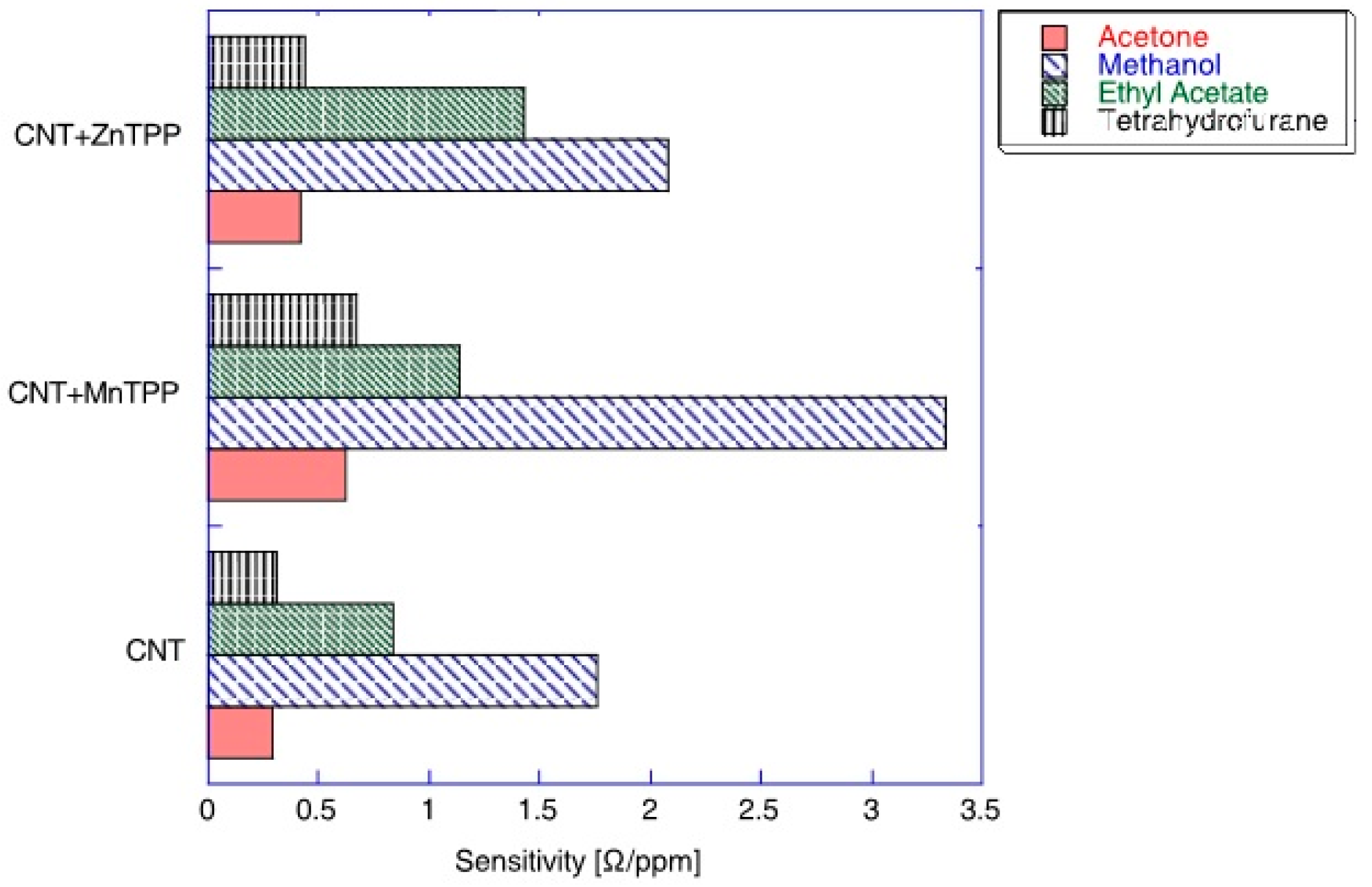
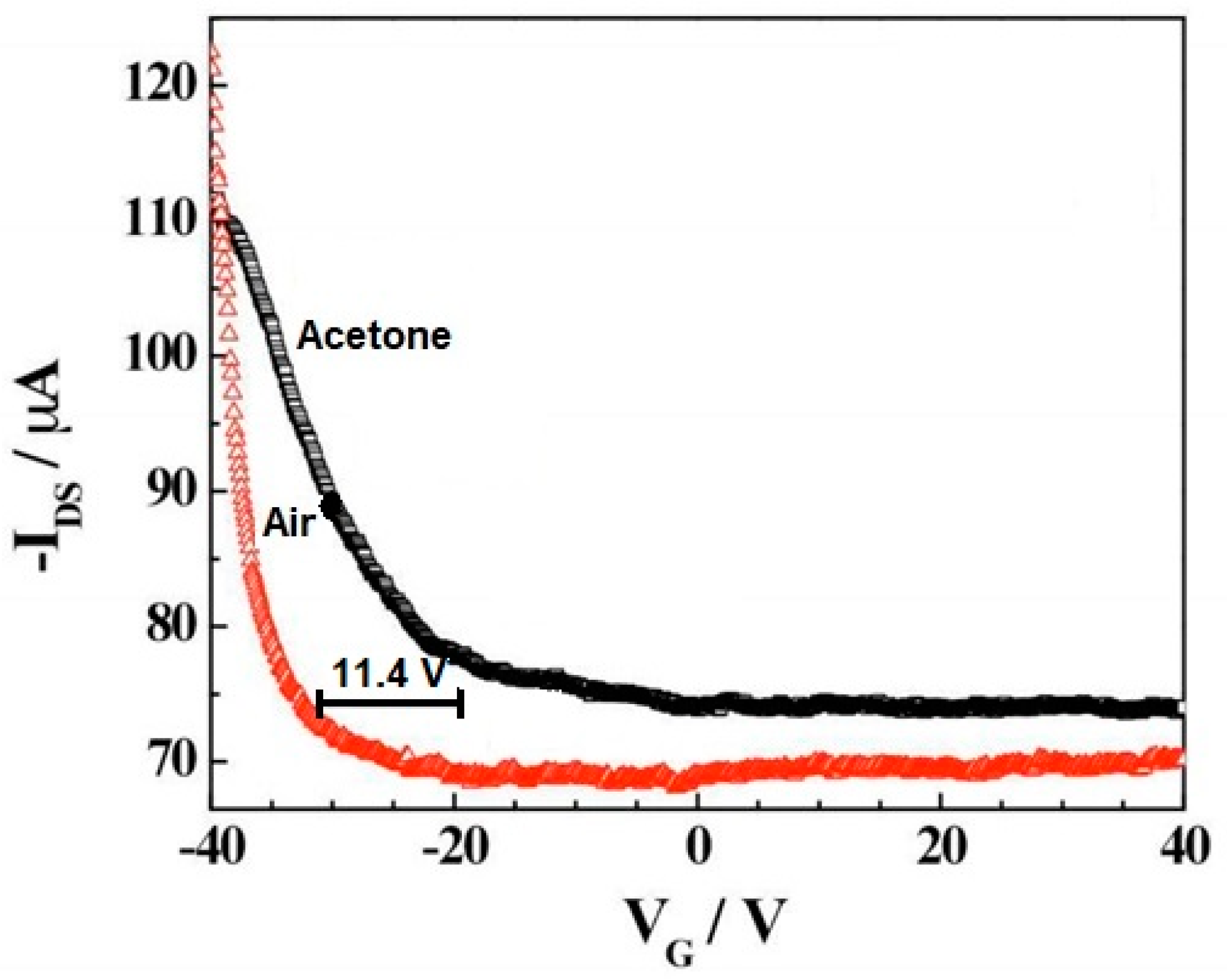
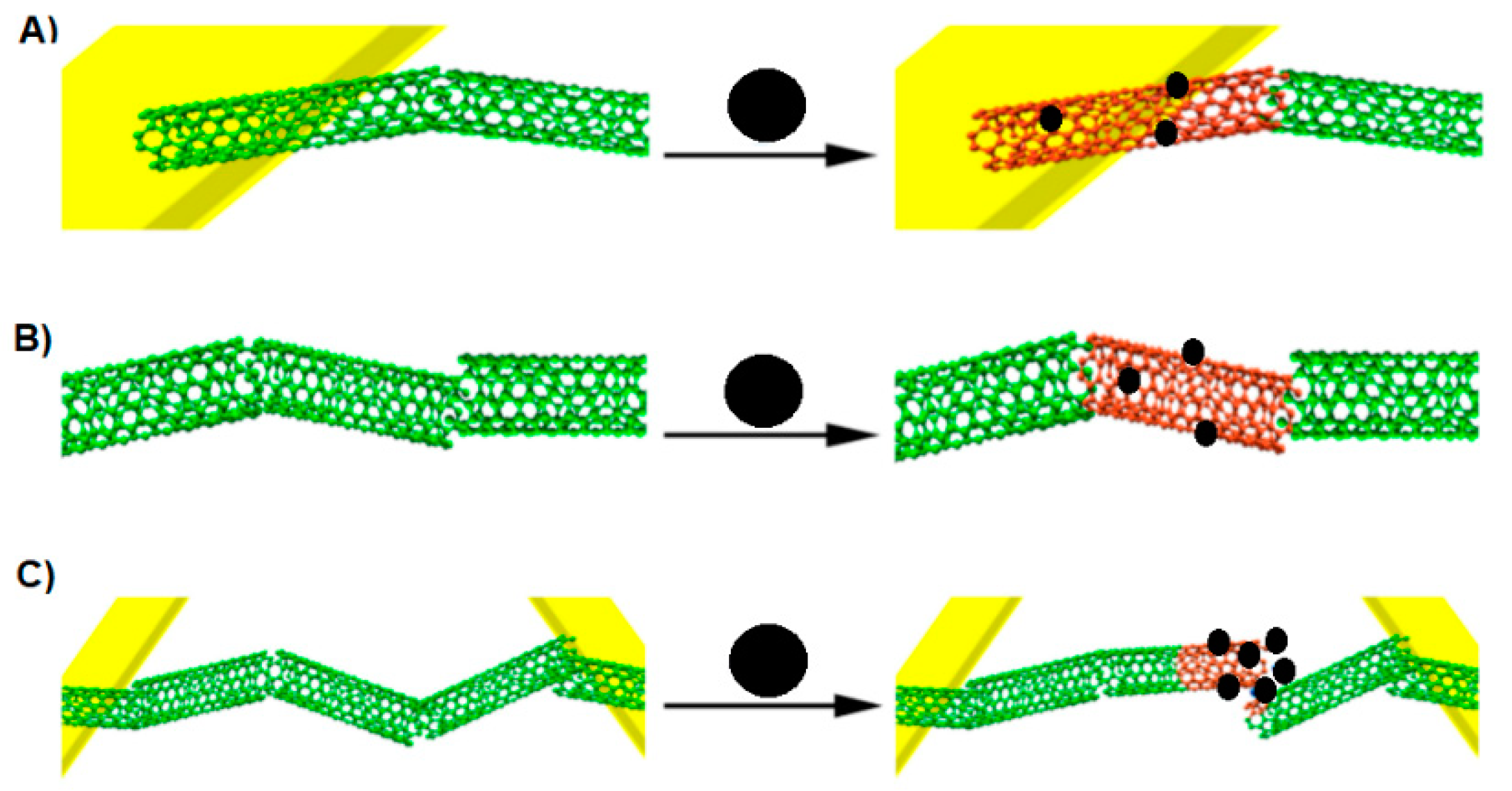



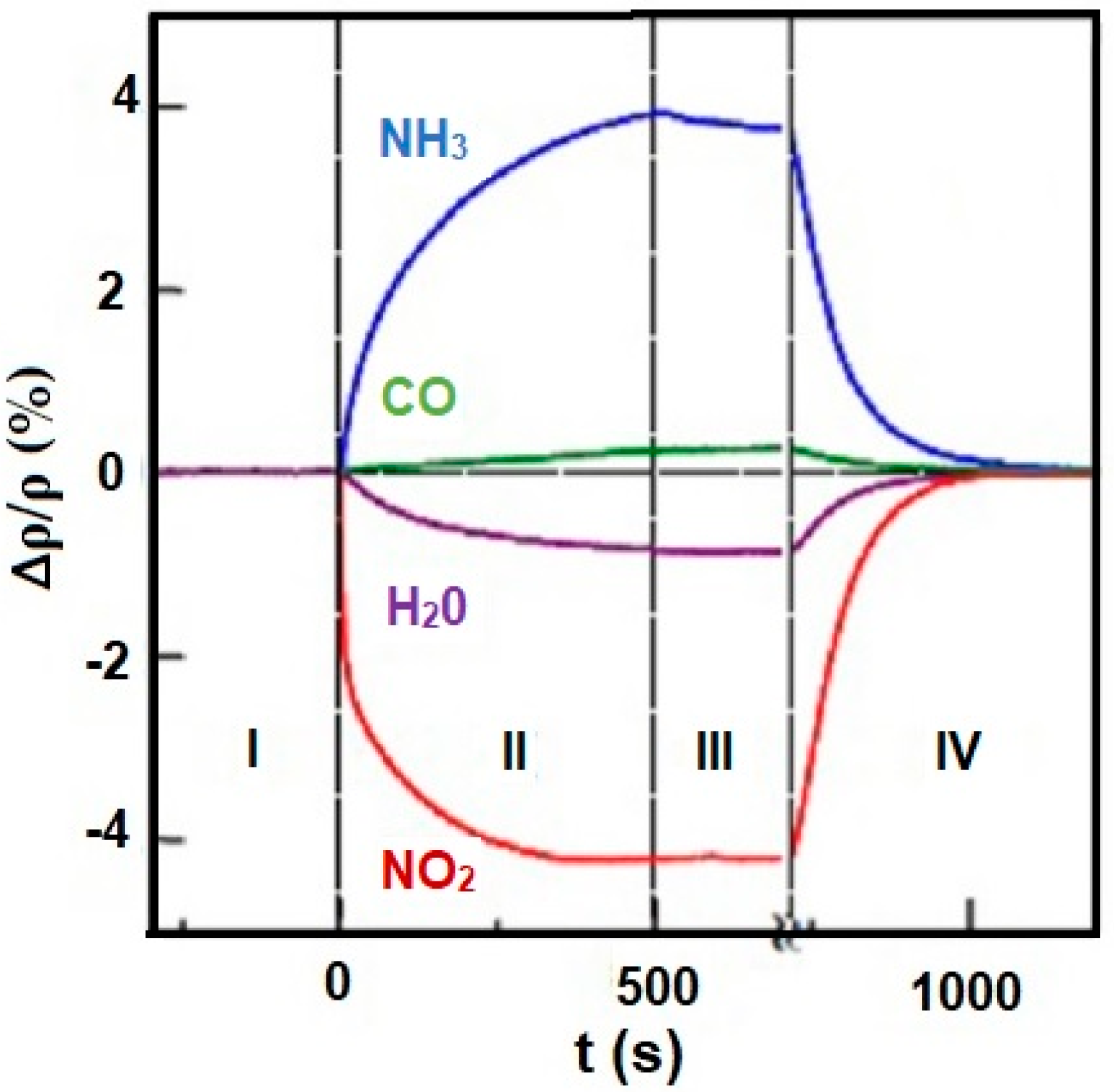
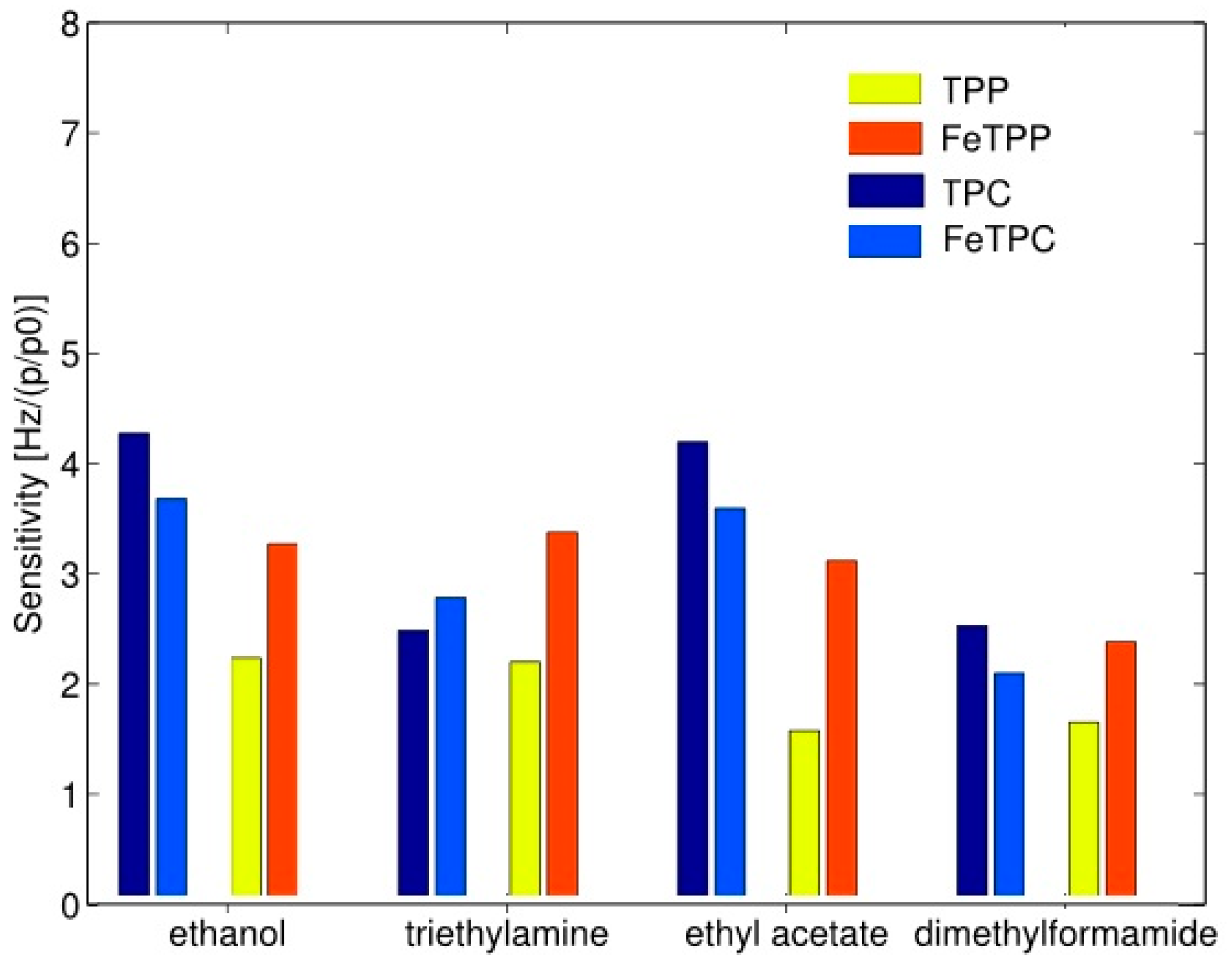

| Type of Sensor | Identified Chemical Compounds | Approximate Detection Limit | Selectivity | Time Response and Responsivity |
|---|---|---|---|---|
| Hybrid CNT-SnO2 [11,22,23,24] | NO2 | 2 ppm | Ethanol, Methanol | ~20 s, 2680 A/W [64] |
| NH3 | 1 ppm | |||
| CO | 0.5 ppm | |||
| O3 | 21 ppb | |||
| H2, CH3OH, C2H5OH | <100 ppm | |||
| Hybrid SWNT-COOH-polymer [18,65] | NH3, NO2 (CH3CH2CH2)2NH, (CH3)2NH, N(CH3)3, NH4OH, Alcohols, Ketones, Aldehydes | 100 ppm 50–1000 ppm | Ammonium hydroxide Acetic acids Acetone Ethanol | ~7 min, 41–64 mA/W [66] |
| Hybrid SWNT-porphirine [67,68] | Alkanes, Amines, Aromatic hydrocarbons, Ketones, Alcohols, Formaldehydes, Nitrotoluene | 5–2000 ppm | Alkanes, Amines, Ketones | 60–80 s, 101–102 A/W [69] |
| G [40,48,70] | NO | 160 ppq | Chloroform, Methanol, Tetrohydrofuran, Acetonitryle, Ethanol, Toluene, Methylene chloride | ~11 s, >1 A/W [71] |
| CO2 | 3 ppm | |||
| NO2 | <200 ppb | |||
| NH3 | 1 ppm | |||
| GO [72,73,74,75] | NH3 | 0.02 ppm | Acetone, H2S, CO, ethanol, methanol, NH3, NO2 Metal oxide | <15 s [71] |
| NO2 | ~1 ppm | |||
| H2 | 20 ppm | |||
| CO | 50 ppm | |||
| H2S | ppb level | |||
| CH3OH, C2H5OH | ppm level | |||
| C3H6O | ppm level | |||
| RGO [72,73,76,77,78,79,80] | NH3, CO | 10 ppm | Benzene, Acetone, Dichloromethane, Toluene, Ethanol, n-hexane NH3 | ~150 s ~18 min, 0.73 A/W [81] |
| NO2 | 0.25 ppm | |||
| H2 | 200 ppm | |||
| H2S, NO | ~5 ppb | |||
| CO2 | 20 ppm | |||
| CH3OH, C2H5OH, | ~100 ppm | |||
| Benzene, Toluene | ppm level | |||
| Hybrid G-polymer [46,82,83] | NH3, CO2 NO2 | 5 ppm 0.25 ppm | NH3, NO2 CO2 H2 H2S Ethanol | 36 s–3 min 8 s 1 s–3 min 5-60 s 2–6 min, ~104 A/W [84] |
© 2019 by the authors. Licensee MDPI, Basel, Switzerland. This article is an open access article distributed under the terms and conditions of the Creative Commons Attribution (CC BY) license (http://creativecommons.org/licenses/by/4.0/).
Share and Cite
Orzechowska, S.; Mazurek, A.; Świsłocka, R.; Lewandowski, W. Electronic Nose: Recent Developments in Gas Sensing and Molecular Mechanisms of Graphene Detection and Other Materials. Materials 2020, 13, 80. https://doi.org/10.3390/ma13010080
Orzechowska S, Mazurek A, Świsłocka R, Lewandowski W. Electronic Nose: Recent Developments in Gas Sensing and Molecular Mechanisms of Graphene Detection and Other Materials. Materials. 2020; 13(1):80. https://doi.org/10.3390/ma13010080
Chicago/Turabian StyleOrzechowska, Sylwia, Andrzej Mazurek, Renata Świsłocka, and Włodzimierz Lewandowski. 2020. "Electronic Nose: Recent Developments in Gas Sensing and Molecular Mechanisms of Graphene Detection and Other Materials" Materials 13, no. 1: 80. https://doi.org/10.3390/ma13010080





